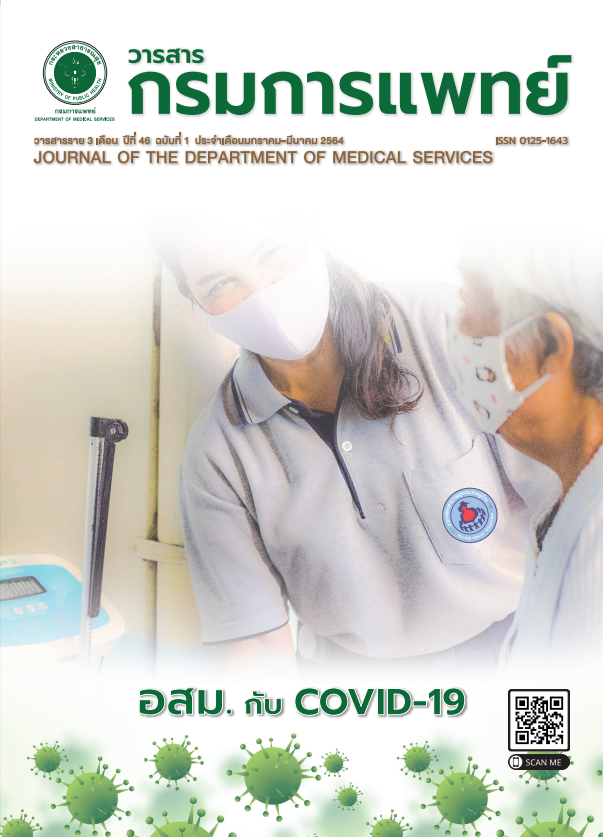การศึกษาเปรียบเทียบผลลัพธ์ทางคลินิกและภาวะแทรกซ้อน หลังการผ่าตัดเปลี่ยนข้อเข่าเทียมระหว่างการใส่ท่อระบายเลือด และไม่ใส่ท่อระบายเลือด
คำสำคัญ:
การผ่าตัดเปลี่ยนข้อเข่าเทียม, ท่อระบายเลือด, การให้เลือด, ติดเชื้อแผลผ่าตัด, ระยะวันนอนบทคัดย่อ
ภูมิหลัง : ปัจจุบันการใส่ท่อระบายเลือดในการผ่าตัดเปลี่ยน ข้อเข่ายังเป็นวิธีที่ปฏิบัติอยู่ทั่วไปเพื่อเป็นการป้องกันเลือดคั่งใน ข้อเข่าซึ่งอาจเป็นสาเหตุทำให้เกิดการติดเชื้อ แต่อาจทำให้ผู้ป่วย ได้รับเลือดหลังผ่าตัดมากขึ้น เพิ่มระยะเวลาวันนอน และอาจทำให้ การเคลื่อนไหวข้อเข่าลดลงหรือทำได้ช้ากว่าที่ควรจะเป็น บางการ ศึกษาเชื่อว่าการไม่ใส่ท่อระบายเลือด ช่วยลดอัตราการให้เลือด และลดระยะเวลาวันนอนโรงพยาบาล ที่ผ่านมาการผ่าตัดเปลี่ยน ข้อเข่าเทียมในโรงพยาบาลสมเด็จพระยุพราชท่าบ่อยังไม่มีการ เปรียบเทียบผลลัพธ์ของผู้ป่วยที่ได้รับการผ่าตัดเปลี่ยนข้อเข่า เทียมระหว่างกลุ่มที่ใส่ท่อระบายเลือดและไม่ใส่ท่อระบายเลือดวัตถุประสงค์ : เพื่อเปรียบเทียบผลลัพธ์ทางคลินิกและภาวะ แทรกซ้อนหลังผ่าตัดระหว่างทั้งสองกลุ่มวิธีการ : ศึกษาข้อมูล ย้อนหลังตั้งแต่ 1 มกราคม 2556 – 30 มิถุนายน 2562 มีผู้ป่วย ทั้งหมด 284 ราย แบ่งผู้ป่วยเป็น 2 กลุ่มดังนี้ กลุ่มที่ได้รับการใส่ท่อ ระบายเลือด (closed suction drain system) จำนวน 152 ราย และกลุ่มที่ไม่ได้รับการใส่ท่อระบายเลือด จำนวน 132 ราย ผู้ป่วย ทั้งหมดในการศึกษานี้ทำการผ่าตัดโดยศัลยแพทย์ออร์โธปิดิกส์ คนเดียวกันโดยศึกษาเปรียบเทียบข้อมูลพื้นฐาน ข้อมูลทางคลินิก และภาวะแทรกซ้อนหลังผ่าตัดระหว่างสองกลุ่มผล : ไม่มีความ แตกต่างกันในข้อมูลพื้นฐานและข้อมูลทางคลินิกระหว่างผู้ป่วยสอง กลุ่มนี้ ระยะเวลานอนโรงพยาบาลพบว่าในกลุ่มไม่ใส่ท่อระบายเลือด มีระยะวันนอนสั้นกว่าแต่ไม่มีความแตกต่างกันอย่างมีนัยสำคัญทาง สถิติ (p=0.060) การได้รับเลือดหลังผ่าตัดพบในกลุ่มใส่ท่อระบาย เลือดมากกว่าแต่ไม่มีความแตกต่างอย่างมีนัยสำคัญทางสถิติ (p= 0.158) วันที่ได้รับการทำกายภาพครั้งแรกหลังผ่าตัดพบว่าไม่มีความ แตกต่างกันระหว่างสองกลุ่ม (p=0.287) การติดเชื้อแผลผ่าตัดที่ ผิวหนังไม่มีความแตกต่างกันอย่างมีนัยสำคัญทางสถิติระหว่างสอง กลุ่ม (p= 0.761 ) เกิดภาวะจ้ำเขียวในกลุ่มที่ไม่ใส่ท่อระบายเลือด มากกว่าแต่ไม่มีความแตกต่างอย่างมีนัยสำคัญทางสถิติ (p=0.128) ไม่พบการการคั่งของเลือด (hematoma)และการติดเชื้อแผล ผ่าตัดชั้นลึกในผู้ป่วยทั้งสองกลุ่มสรุป : การใส่ท่อระบายเลือดและ ไม่ใส่ท่อระบายเลือดหลังการผ่าตัดเปลี่ยนข้อเข่าเทียมไม่พบความ แตกต่างของการได้รับเลือดทดแทน การติดเชื้อแผลผ่าตัดและ ระยะวันนอนในโรงพยาบาล
เอกสารอ้างอิง
McAlindon T, Zucker NV, Zucker MO. 2007 OARSI recommendations for the management of hip and knee osteoarthritis: towards consensus? Osteoarthritis Cartilage 2008;16:636–7.
Christensen R, Astrup A, Bliddal H. Weight loss: the treatment of choice for knee osteoarthritis? A randomized trial.Osteoarthritis Cartilage 2005; 13:20–7.
Hovik LH, Winther SB, Foss OA, Gjeilo KH. Preoperative pain catastrophizing and postoperative pain after total knee arthroplasty: a prospective cohort study with one year follow-up. BMC Musculoskelet Disord 2016; 17:214.
Alexander JW, Korelitz J, Alexander NS. Prevention of wound infections. A case for closed suction drainage to remove wound fluids deficient in opsonic proteins. Am J Surg1976; 132:59-63.
Esler CN, Blakeway C, Fiddian NJ. The use of a closed-suction drain in total knee arthroplasty. A prospective, randomized study. J Bone Joint Surg Br 2003; 85: 215-7.
Minnema B, Vearncombe M, Augustin A, Gollish J, Simor AE. Risk factors for surgical-site infection following primary total knee arthroplasty. Infect Control Hosp Epidemiol 2004; 25:477–80.
Xu H, Xie J, Lei Y, Huang Q, Huang Z, Pei F. Closed suction drainage following routein primary total joint arthroplasty is associated with a higher transfusion rate and longer postoperative length of stay: a retrospective cohort study. J Orthhop Surg Res 2019; 14:163.
De Andrade MA, de Oliveira Campos TV, Silva BF, de Assis ME,de Castro Boechat L, Biondi LF, et al. Six month follow-up of patients submitted to total knee arthroplasty with and without placement of suction drainage devices. Rev Bras Ortop 2015;45: 549–53.
Demirkale I, Tecimel O, Sesen H, Kilicarslan K, Altay M, Dogan M.Nondrainage decrease blood transfusion need and infection rate in bilateral total knee arthroplasty. J Arthoplasty 2014; 29:993-7.
Wang D, Xu J, Zeng WN, Zhou K, Xie TH, Chen Z, et al. Closed suction drainage is not associated with faster recovery after total knee arthroplasty: a prospective randomized controlled study of 80 patients. Orthop Surg 2016; 8:226-33.
Bagsby D, Pierson JL. Functional outcome of simultaneous bilateral versus unilateral total knee arthroplasty.Orthopedics 2015; 38:e43-47.
Zhang Q, Liu L, Sun W, Gao F, Zhang Q, Cheng L, et al.Are closed suction drains necessary for primary total knee arthroplasty? A systematic review and meta-analysis.Medicine (Baltimore) 2018; 97: e11290.
Al-Zahid S, Davies AP. Closed suction drains, reinfusion drains or no drains in primary total knee replacement? Ann R Coll Surg Engl 2012; 94:347-50.
Ho KM, Ismail H. Use of intravenous tranexamic acid to reduce allogenic blood transfusion in total hip and knee arthroplasty:a meta-analysis. Anaesth Intensive Care 2003; 31: 529-37.
Bagsby DT, Samujh CA,Vissing JL, Emoson JA, Domery DC, Malkani AL. Tranenexemic acid decrease incidence of blood transfusion in simultaneous bilateral total knee arthroplasty. J Arthroplasty 2015; 30:2016-9.
Fu D, Li G, Chen K, Zeng H, Zhang X, Cai Z. Comparison of clinical outcome between simultaneous - bilateral and staged-bilateral total knee arthroplasty: a systematic review of retrospective studies. J Arthroplasty 2013; 28:114-7.
Chen JY, Lee WC, Chan HY, Chang PC, Lo NN, Yeo SJ. Drain use in total knee arthroplasty is neither associated with a greater transfusion rate nor a longer hospital stay. Int Orthop 2016;40:2505-9.
Nishitani K, Kuriyama S, Nakamura S, Ito H, Matsuda S. A multivariate analysis on the effect of no closed suction drain on the length of hospital stay in total knee arthroplasty. Knee Surg Relat Res 2019; 31: 25–30.
Sharma GM, Palekar G, Tanna DD. Use of closed suction drain after primary total knee arthroplasty-an overrated practice.SICOT J 2016; 2:39.
Wang D, Xu J, Zeng WN, Zhou K, Xie TH, Chen Z, et al. Closed suction drainage is not associated with faster recovery after total knee arthroplasty: a prospective randomized controlled study of 80 patients. Orthop Surg 2016;8:226-33.
Omonbude D, El Masry MA, O’Connor PJ, Grainger AJ, Allgar VL, Calder SJ. Measurement of joint effusion and haematoma formation by ultrasound in assessing the effectiveness of drains after total knee replacement:a prospective randomized study. J Bone Joint Surg Br 2010; 92:51-5.
Willemen D, Paul J, White SH, Crook DW. Closed suction drainage following knee arthroplasty. Effectiveness and risks. Clin Orthop Rela Res 1991; 4:232-4.
Li N, Liu M, Wang D, He M, Xia L. Comparison of complications in one-stage bilateral total knee arthroplasty with and without drainage. J Orthop Surg Res 2015; 10:3.
Jhurani A, Shetty GM, Gupta V, Saxena P, Singh N. Effect of closed suction drain on blood loss and transfusion rates in simultaneous bilateral total knee arthroplasty: a prospective randomized study. Knee Surg Relat Res 2016; 28:201-6.
Erne F, Wetzel S, Wülker N, Gesicki M, Hofmann UK. Closed suction drainage after primary total knee arthroplasty: a prospective randomized trial. J Knee Surg 2018; 31:804-10.
ดาวน์โหลด
เผยแพร่แล้ว
รูปแบบการอ้างอิง
ฉบับ
ประเภทบทความ
สัญญาอนุญาต

อนุญาตภายใต้เงื่อนไข Creative Commons Attribution-NonCommercial-NoDerivatives 4.0 International License.
บทความที่ได้รับการตีพิมพ์เป็นลิขสิทธิ์ของกรมการแพทย์ กระทรวงสาธารณสุข
ข้อความและข้อคิดเห็นต่างๆ เป็นของผู้เขียนบทความ ไม่ใช่ความเห็นของกองบรรณาธิการหรือของวารสารกรมการแพทย์



